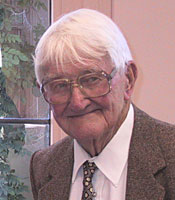
You can order the DVD from the Academy for $15 (including GST and postage)
Professor Anton Hales was interviewed in 2002 for the Interviews with Australian scientists series. By viewing the interviews in this series, or reading the transcripts and extracts, your students can begin to appreciate Australia's contribution to the growth of scientific knowledge.
The following summary of Hales's career sets the context for the extract chosen for these teachers notes. The extract covers his thoughts on Australia's seismological achievements and prospects. Use the focus questions that accompany the extract to promote discussion among your students.
Anton Hales was born in South Africa in 1911. He was educated at the University of Cape Town where he earned a BSc in 1929, an MSc in 1930 and a PhD in 1936. He also studied at the University of Cambridge in Britain, earning a BA in 1934 and an MA in 1952.
Hales was Director of the Bernard Price Institute of Geophysical Research at the University of Witwatersrand from 1954 to 1962. Originally trained as a mathematician, he applied quantitative methods to many geological problems. His studies, on land and sea, of the structure of the Earth's crust and mantle made a major contribution to our knowledge of the planet's interior.
He served as the first Head of the Geoscience Division at the Southwest Center for Advanced Studies (later the University of Texas at Dallas) from 1962 to 1973.
He moved to the Australian National University in 1973 as foundation Director of the Research School of Earth Sciences and held this position until 1978.
Hales was elected a Fellow of the Australian Academy of Science in 1976.
That returns us to your arrival at the ANU, and the seismology program which you set about building up. How did the program get on?
Well, because of a partly political problem we never published some of the early work. You see, the BMR, the Bureau of Mineral Resources as it was then, had a similar idea of building up seismology to do regional surveys and so one had to be a little cautious about that.
I have mentioned some of the people who were involved in the research school. Another was Muirhead, and also we had John Cleary, who had done a PhD on surface waves. It may not have been a particularly important seismological approach, but it was done neatly and well. Cleary had spent about three years in Dallas, and at least one of his kids was born there.
As Director of RSES you set up a lot of the portable networks, you collected a lot of data, and you established a lot of new information on the upper mantle structure beneath the Australian continent. How would you view that today?
Looking back, I would say that we probably should have done more and done it better. Really, worldwide, there isn't enough known about the crust of the Earth in most areas. The United States may be the best, perhaps, but the BMR has done a fair amount here. On an area for area comparison, it might well turn out that they have done more than has been done in the States – or have done it more systematically.
Where do you think seismology is heading now?
That is a difficult question. I think that systematic surveying will be carried out which may add detailed, more uniformly spread information, and that it will be possible to do experiments which look in more detail into particular sections than has so far been done. But my view at the moment is that it is the surface wave data that will give the broadest overall view, because it doesn't sample only where you put the instruments. It can be used to derive information for paths in inaccessible places.
For instance, you see, it is very difficult to get body wave data in the range of 100° arc distance because of the instrument distribution and the data sources. To get the overall picture you are dependent largely on surface wave data. Certainly ocean bottom instrumentation is essential, but you do want surface wave data in more places than they have it at present.
Select activities that are most appropriate for your lesson plan or add your own. You can also encourage students to identify key issues in the preceding extract and devise their own questions or topics for discussion.
© 2025 Australian Academy of Science